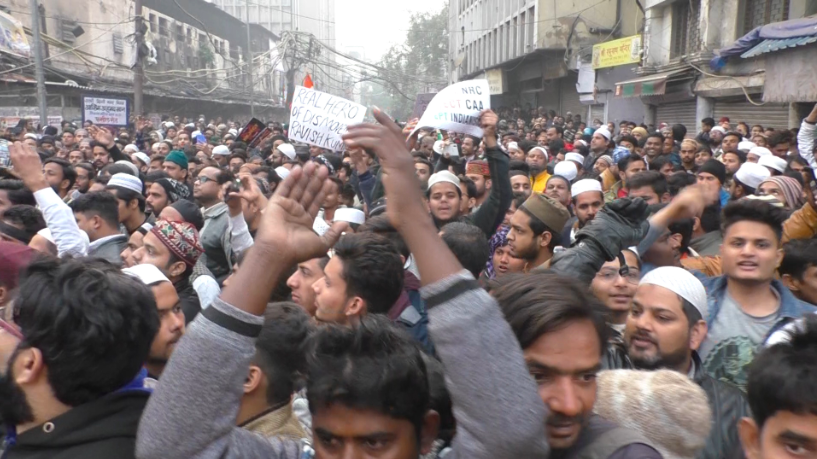Amid High Drama, Chandrashekhar ‘Azad remanded to 14 days in judicial custody

New Delhi: Bhim Army chief Chandrashekhar ‘Azad’ was remanded to 14 days in judicial custody by a Duty Metropolitan Magistrate at New Delhi’s Tis Hazari Court on Saturday. 15 people alleged to be involved in violence in Old Delhi’s Daryaganj during protests against the Citizenship (Amendment) Act, 2019 were sent to two days in judicial custody.
Meanwhile, the Karkardooma court remanded 11 accused in violence in Seemapuri to 14 days in judicial custody.
Azad, who was detained by the police early on Saturday, was whisked into the courtroom around 6.20 pm. Shortly before, advocate Mahmood Pracha, who appeared for him, had expressed concern regarding his whereabouts. “We don’t know whether he is alive or dead,” he told the court.
Rejecting his bail application, the court remanded him to judicial custody for allegedly provoking violence during the anti-CAA protests in Daryaganj. “At this stage, this court is of the considered view that substantial grounds for granting bail to the accused are not made out,” stated the Duty Metropolitan Magistrate’s one-page order.
Azad had slipped out of the Delhi Police’s detention during a massive protest march from Jama Masjid. An FIR was registered against him for allegedly “instigating crowd” and “proving violence” near Delhi Gate.
He later surfaced and staged a sit-in at the Jama Masjid stairs, along with hundreds of people. He surrendered very late in the night in exchange for the release of several people who the police had detained.
“All those detained should be surrendered and then I will surrender. Friends, continue fighting and stay united for the Constitution. Jai Bhim, Jai Constitution,” he had tweeted.
Earlier, Duty Metropolitan Magistrate Arjinder Kaur rejected the Delhi Police counsel’s plea for a 14-day judicial remand for those allegedly involved in the Daryaganj violence. The court did not hear their simultaneous bail petition, saying that the appropriate court — that of the Chief Metropolitan Magistrate (CMM) — would hear the matter on December 23. The accused were produced before the court at 4 pm after regular hours and thus, the Duty Metropolitan Magistrate conducted the hearings.
The FIR (first information report), which was filed on December 20 based on the complaint of Daryaganj SHO (station house officer), said thousands of people began marching from Jama Masjid to Delhi Gate after an “inciting” speech delivered by Chandra Shekhar ‘Azad’ after the Friday prayers.
The protest march — claims the FIR — was organised without permission and therefore, was an unlawful assembly. The police had used water cannons to disperse the unruly mob later in the evening after the protesters began stone pelting to disperse the crowd. A car was set on fire by the mob, the FIR said.
The prosecutor who appeared for the Delhi police argued that the act was planned and done in a premeditated manner and the investigation is ongoing.
“There were serious offences. Public property was damaged. Police officials have been seriously injured. There is a need for an in-depth investigation. These men should be kept behind bars while investigation is going on,” he said.
Asking for a copy of the remand application, Senior Advocate Rebecca Mammen John, appearing for 15 accused protesters, opposed the plea for grant of judicial custody. She argued that most of the offences are bailable in nature. “The allegation is that a car parked on the road side was set on fire. Even assuming that any of these men had anything to do with the incident, how can they be booked under sections relating to assault on public servants, which is punishable by a maximum of three years. Section 3 and 4 of the Prevention of Damage to Public Property Act, 1984 contains provisions of up to five years of imprisonment. Public property is property owned by the government. How is this Act being invoked against them when the damaged property was not a government property?” she said.
She added that those arrested are aged between 22 and 25 and are daily wagers. There was no common intention, she contended, adding that they were detained when they were in the area to offer Friday prayers.
“You (the Delhi Police) pick up anyone you want to and then invoke offences. You did not spare even minors. Is there any specific allegation against any of these persons,” she asked.
She further submitted that one arrested person is a juvenile aged 15.
The Investigating Officer (IO), in response, said, “According to his (the particular accused) statement, he is 23. The investigation is at an initial age. We will take further action after verification of his age.”
The accused in the Daryaganj clash case have been booked under sections 147, 148, 149, 436, 332, 323 (mischief by fire or explosive substance with intent to destroy house, etc.), 427 (causing damage to the amount of fifty rupees), 323 (voluntarily causing hurt), 353 (assault or criminal force to deter public servant from discharge of his duty), 186 (obstructing public servant in discharge of public functions), 120-B (criminal conspiracy) and 34 (acts done by several persons in furtherance of common intention) of the IPC. Section 3 (causing damage to public property) and 4 (causing damage to public property by fire or explosive) of Prevention of Damage to Public Property Act, 1984 have also been slapped against them.
The accused in the Seemapuri case, who were represented by Senior Advocate Nitya Ramakrishnan, were charged under sections 307 (attempt to murder), 143 (unlawful assembly), 147 (rioting), 148 (rioting, armed with deadly weapons), 149 (every member of unlawful assembly guilty of offence committed in prosecution of common object), 186 (obstructing public servants from discharging official functions), 332 (causing hurt to deter public servant from his duty), 353 (assault or criminal force to deter public servant from discharge of his duty) and 109 (abetment) of the Indian Penal Code (IPC) and Section 3 of the Prevention of Damage to Public Property Act, 1984. The Karkardooma Court rejected their bail pleas, saying that serious sections, including Section 307 (attempt to murder), are involved.
DRAMA OUTSIDE COURTROOM
Ahead of the remanding of Bhim Army chief Chandrashekhar ‘Azad’, a number of journalists were denied entry into the courtroom. Only a few senior legal correspondents managed to enter. The police had locked the main door of the court building without citing any order or reason.
When the police were asked by the journalists to let them inside, they refused saying they didn’t have the necessary orders. They were also not willing to provide the numbers of their senior officers.
When some journalists managed to enter the building through the rear gate, they were stopped at the entrance to the courtroom where Azad’s remand hearing was being conducted. Notably, there was no order of in-camera hearing till that time.
As the ruckus grew, the judge finally let the journalists enter the courtroom. But she immediately passed an order for an in-camera hearing, but cited no specific reason.
The senior journalists who were inside were also asked to leave the room. Adv Pracha objected to it but was overruled by the judge.
Under Code of Criminal Procedure (CrPC), a bail hearing cannot be held in-camera unless it is a trial in a rape case or under some special laws such as UAPA. But Azad has not been booked under any such law.
Section 327 of Cr.PC says, “The place in which any criminal court is held for the purpose of inquiring into or trying any offence shall be deemed to be open.”
Later, the journalists gave a written complaint to District Judge Kamini Lau against the treatment meted out to them and the bar on their reporting. The judge agreed that there was no reason for such restrictions. Orally terming the incident “absolutely unfortunate”, she promised that she would look into it.
Get the latest reports & analysis with people's perspective on Protests, movements & deep analytical videos, discussions of the current affairs in your Telegram app. Subscribe to NewsClick's Telegram channel & get Real-Time updates on stories, as they get published on our website.
























